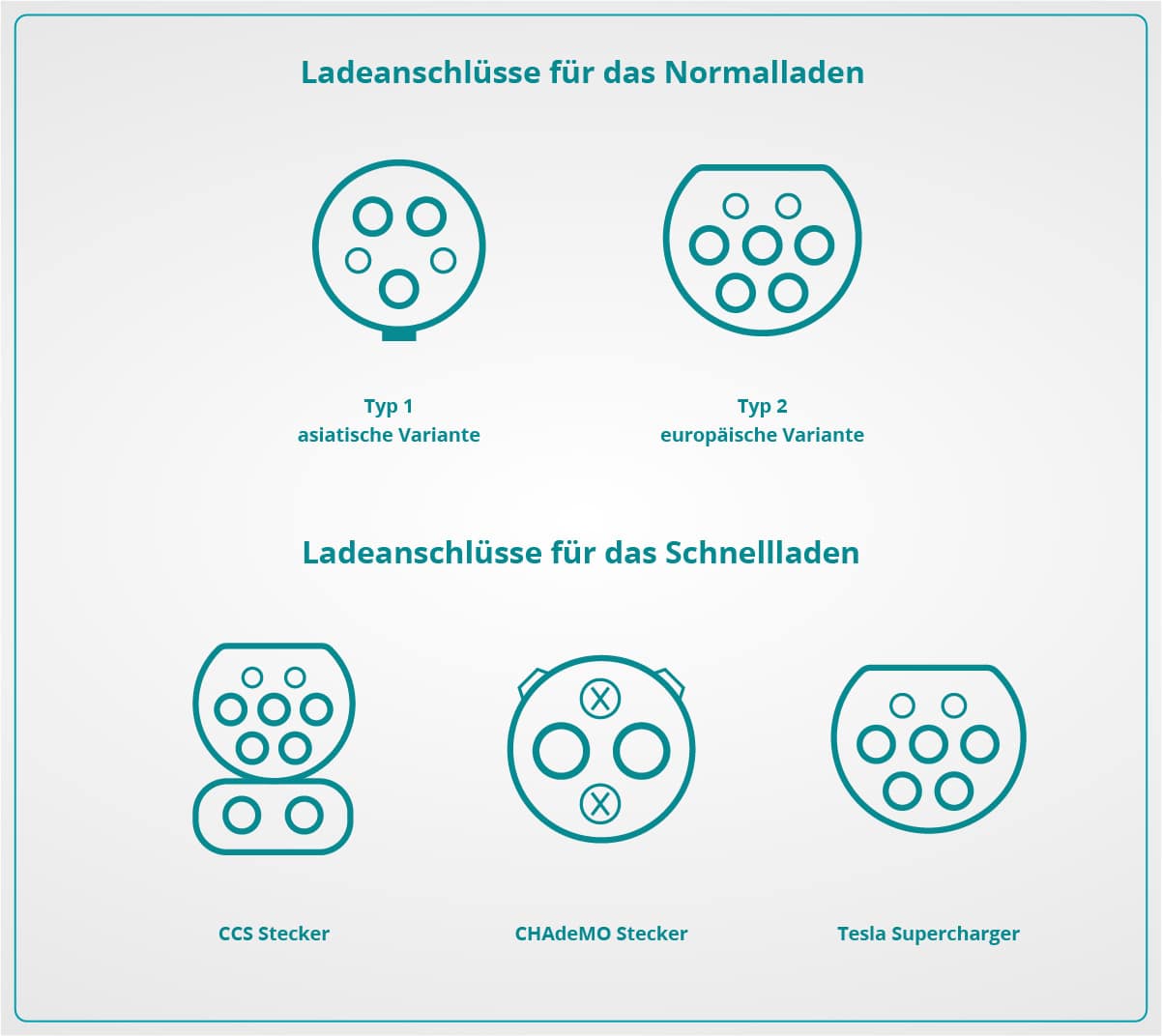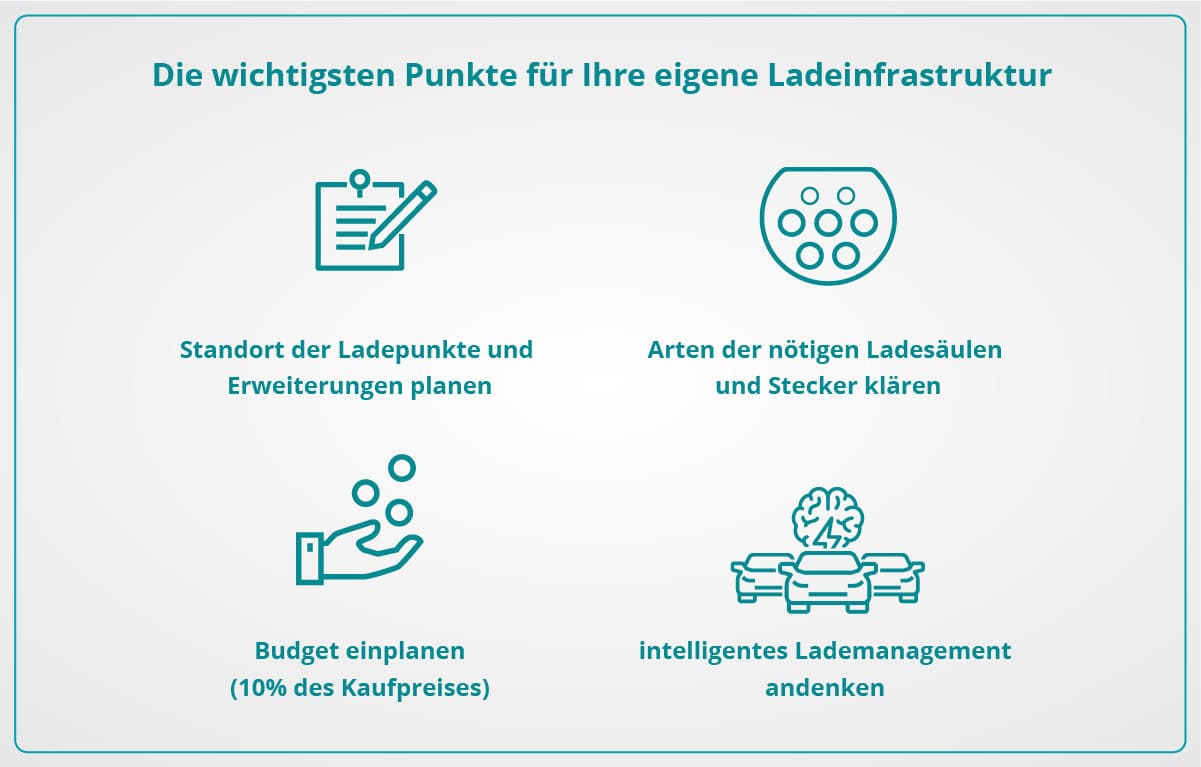In our article on fleet analysis, we already explained how you can determine whether electric cars can complement your fleet. In order to be able to charge the electric car at your own charging stations, you may need your own charging infrastructure on site. We answer the most frequently asked questions if you have decided to set up your own small or larger infrastructure.
Would you like to learn more about e-mobility for SMEs? Get your free whitepaper now!
WE ANSWER THESE QUESTIONS ON THE ON-SITE LOAD INFRASTRUCTURE:
- Do I need my own charging infrastructure on site?
- How do I determine how many charging points I need?
- Are there differences between individual vehicle types such as e-cars or e-bikes?
- How much effort do I have to calculate for planning, project planning and installation?
- What is intelligent charging management and do I need it?
- Can I find out for myself whether my existing power grid meets the requirements?
For the best possible expertise, we conducted an interview with project manager Maximilian Schwarze of Intrasol GmbH from Nordhausen. InTraSol - Intelligent Traffic Solutions GmbH designs, plans and projects nationwide concepts for the market development of electric mobility, car sharing and renewable energies.
"Insofar as this initial analysis is positive for electromobility, the situation of a charging infrastructure on site must be considered," says Maximilian Schwarze. It can be advantageous if charging options are already available in the direct vicinity of the company location. Alternatively, the company must set up its own charging points. These can be partly subsidised.
Related to this is the question of the charging profiles of the electric cars to be purchased, i.e. when and where they are to be charged. Generating one's own electricity through a photovoltaic system can also bring real added value here - in the long term, also financially. However, advice from appropriate engineering firms or the local energy supply company is recommended due to the wide range of possibilities.
HOW DO I DETERMINE WHICH CHARGING OPTIONS I NEED?
After the fleet analysis, you should know about the following points:
- Which vehicles can be replaced by electric cars?
- How often are they on the road on average?
- Where can they be loaded and how often?

Based on these findings, you know the number of electric vehicles to be charged and the expected driving profile. In order to be able to determine a charging profile from this, further questions must be answered:
- What charging power can my e-vehicles provide?
- How many vehicles need to charge at the same time?
- How long are the downtimes of the vehicles?
- As an employer, do I want to provide charging facilities for my employees' private vehicles?
- As a company, do I want to provide charging facilities for my customers?
ARE THERE DIFFERENCES BETWEEN INDIVIDUAL TYPES OF VEHICLE, SUCH AS ELECTRIC CARS OR E-BIKES, IN RESPECT OF THE CHARGING INFRASTRUCTURE ON SITE?
Depending on the vehicle type, the charging power or charging principle differs between "fast charging capable" and "not fast charging capable". A charging power greater than 22 kW is referred to as fast charging. Many electric cars can now even be charged with up to 150 kW direct current - but they don't have to be.
"Smaller electric vehicles in particular can also be charged without any problems via the conventional household socket," reports Intrasol employee Maximilian Schwarze.

Up to 11 kW charging power is usually possible in consultation with the energy supply company. The charging connections specifically designed for electric vehicles are Type 2 for alternating current or CCS for direct current. Most normal charging stations and wallboxes are equipped with a type 2 plug and can be easily installed on the premises. 22 kW or more charging power can only be charged with direct current.
In this case, special connection conditions are necessary and require high investment costs. The best way to find out whether such a conversion would be possible and what costs you would incur is to ask the energy supply company in your region.
The connections for e-bikes are diverse and range from USB-C to the household socket to the Type 2 plug. So in the end, which charging pillars or charging stations are best suited for your charging infrastructure depends on the type of vehicle. When buying a car, you can also ask about this.
HOW MUCH EFFORT DO I HAVE TO CALCULATE FOR PLANNING, PROJECTING AND INSTALLATION?
As a rule of thumb, calculate about 10 percent of the purchase price for the acquisition and installation of the hardware per electric car to be purchased. If you plan to further expand electric mobility after successfully testing the vehicles, Maximilian Schwarze has another tip for you: "Think long-term when installing your charging infrastructure. Lay empty pipes in the car park area or already lay cable connections to be able to connect more car parks to it in the future."
The charging infrastructure can also be linked to energy generation on your own premises, as FSD Fahrzeugsystemdaten GmbH, for example, has proven with its "sunflowers". Should you prefer such a model, you should enter into discussion with external consultants at an early stage.
SUMMARY: WITH THESE POINTS EFFICIENT TO THE OWN SHOPPING INFRASTRUCTURE ON SITE
Insofar as you have decided to take the costs for the charging infrastructure into your own hands locally and set up your own infrastructure for charging points for electric cars, you will find experienced advisors at planning offices and your municipal energy suppliers. On umschalten.de we have summarised the most important points for joint planning:
- Make a plan of your car park and design where you can locate charging points and whether they could be expanded in these places.
- Clarify at an early stage which charging columns, charging points and plugs you need for the vehicles to be purchased.
- Plan about 10 percent of the purchase price per vehicle for your own charging infrastructure.
- If you have several vehicles, think about a smart charging management system.

You can also find extensive information on e-mobility in our white paper. Do you have questions or a topic idea? Feel free to send us an email at frag@umschalten.de!





